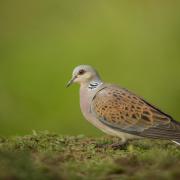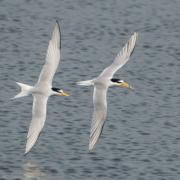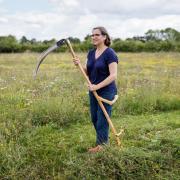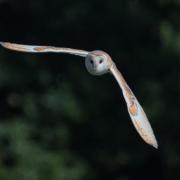October. The very thought of it thrills Suffolk's birdwatching community. An impassioned John Grant explains why
October. The very thought of it thrills Suffolk’s birdwatching community. An impassioned John Grant explains why
Autumn. Season of mists and mellow fruitfulness. Those old adages always seem heavy on the alliteration don’t they? Well, here’s another ‘M’ we could add to this autumnal phrase… migration.These columns have dwelt before on the marvels of migration. But when we consider October and the full extraordinary, awe-inspiring, exhilarating, truly mind-boggling almighty miracle, in which some internal imperative within a bird forces it to traverse perhaps half the world, well, for once I am left speechless or, rather, wordless. October is the month alright. The month to stand on a Suffolk beach at dawn and be right there amongst this unfolding epic of a story in the skies. Stirs the senses this does, if you catch a few hours of full-blown movement. There are times when it seems to be raining migrant birds coming straight in off the North Sea or coasting along the landlines of our beaches. Okay, their numbers may not be so breathtaking as they once were – heaven knows, it’s not just “our own” British breeding birds that are having a tough time of it after decades of rampant, intensive agriculture and the numerous other threats they have faced.Eastern and northern Europe have their environmental problems too, but at least they do not seem to have had quite such a catastrophic effect on their birdlife as ours have.Yet. So, given the right weather conditions – preferably an easterly breeze, much cloud cover and perhaps a little rain around dawn, you can witness avian action on a thrilling scale.It’s a time when all manner of movement is taking place and, hence, all manner of species that are scarce and downright rare in Britain can, and do, turn up. The northern hemisphere’s winter is approaching and it’s time to move to more clement climes. And Suffolk – with Lowestoft the country’s most easterly point and the county being well and truly “on the bulge” of East Anglia, jutting right out into the North Sea – is well-placed to be the first landfall of many of these travellers from afar.October is noted for its rarities. Birders are on red alert all through autumn but it is in October that some of the more rarity-fixated enthusiasts are in a state of agitated meltdown. The twitchiness gets so bad it is sometimes unbearable. Indeed, many’s the birder’s marriage that has fallen apart under the strains of “Octoberitis.”But it is not just the waifs from Siberia, central Asia, or indeed even from Canada or the United States, that can excite. That blackbird that has just started frequenting your garden might not be a ‘local’. It might well be from some northern Scandinavian forest. That robin that has just turned up might not be local either. It too could have its origins well to the east beyond our shores.And there’s one species that, while not at all rare in Britain or Europe, always, simply always, provides wonderment when it is seen hopping about in our coastal trees and bushes after a long, arduous journey across the North Sea. The goldcrest.This tiny scrap of a bird weighs about five or six grammes. It is Britain’s smallest breeding bird species. And yet somehow, utterly miraculously, thousands upon thousands set out from their northern European breeding sites and attempt to cross the great barrier that the sea represents. Many do not make it and succumb to the perils of adverse weather but many do battle through and reach Suffolk shores.Each and every goldcrest that enlivens a watcher’s October morning is a triumph. A triumph of navigation, physical endurance and sheer resolve. Wonderment did I say? It’s surely beyond even that.Actually, you do not even have to be at the coast to witness such triumphs. Migration through Suffolk is often on a pretty broad front. You don’t need to be in a wild place and it needn’t even be daylight.
Each and every goldcrest that enlivens a watcher’s October morning is a triumph. A triumph of navigation, physical endurance and sheer resolve. Wonderment did I say? It’s surely beyond even that.
Take Ipswich town centre, or, say Bury St Edmunds town centre, Haverhill, Eye, Sudbury...anywhere. Late at night, when the revellers have staggered home and the traffic at last has abated, listen. You might hear a thin, drawn out “tseee” and then another, and another. The wonder of migration is taking place unseen far above you. These are redwings. Small, smart, northern thrushes pouring across Suffolk’s dark skies to winter in their thousands with us. And very, very welcome they are too.With all these migrant species, timing is of the essence. They have to arrive when food is available. And none times its arrival better than the redwing, which uses our berries as fuel for its further, westward wanderings, or simply for survival during a Suffolk winter.As veteran Suffolk botanist Peter Lawson explains, there is an abundance of food ready and waiting for the redwing and so many other migrant species.He writes: “October is a time of plenty in our country hedgerows, which are laden with colourful fruits and berries for both humans and birds to harvest. As the leaves start to take on their autumn tints, the annual wild fruit crop reaches its peak.“Blackberries come instantly to mind as the most popular one to gather for jams and pies, but not all are of the same quality, since there are about 300 different kinds in Britain. Elder is another universal and fruitful tree, bearing masses of small purply-black berries useful for making wines, preserves and puddings. Our familiar blackthorn bushes, which were white with blossom in the spring, should now be covered with small, purple fruits used to make sloe gin. These are very sour compared with the occasionally found wild plums and bullaces, which are normally yellow or red and quite sweet.“The little yellow fruits of the crab apple tend to remain on the trees till winter approaches and are popular for preserves, though some of the trees will be domestic apples which have “gone wild”.“Readers who were at school in the war years will remember collecting masses of orange rose hips, which were used to make a syrup rich in vitamin C at a time when the usual source, imported fruits, were not available. These are still popular with our birds, as are many other berries not palatable to humans.”So it is that autumn, exemplified by October, is indeed a season of “mists and mellow fruitfulness.” But take a look around you and almost everywhere in Suffolk you will see, and be uplifted by, migration. Uplifted, that is, unless you have a heart of stone.
NOW'S THE TIME TO SEE...
RED DEER: As if the spectacle of bird migration is not enough, October offers a mammal spectacular, too. And it’s our largest mammal that is involved so it is doubly thrilling spectacle at that. Red deer – the “Monarch of the Glen” in Scotland – are at the top of the hierarchy of our heaths down here in Suffolk. October is by far the best time to see them as they congregate for their rut, in which great antlered males compete with each other for the, shall we say, affections of females. The best place to see and hear the posturing, the bellowing and sometimes the crashing together of sets of impressive antlers is at the RSPB’s Minsmere reserve, near Westleton. Staff and volunteers are on hand at an area signed off the Westleton-Dunwich road to help you view the animals and learn about their lifestyle. Details of viewing will be on the RSPB’s website. The herd involved here is said to be the biggest in lowland Britain – experience tells us that it also may well be the loudest!


























